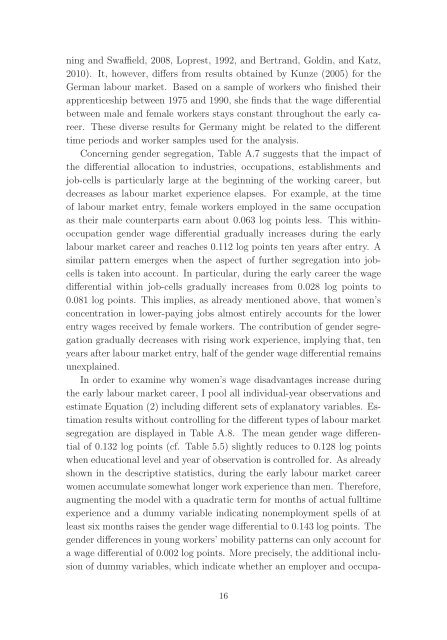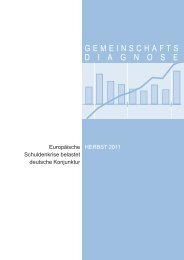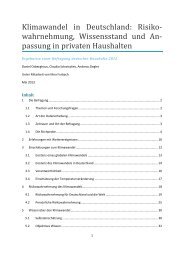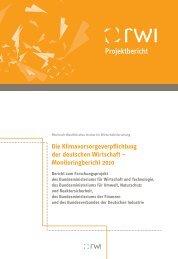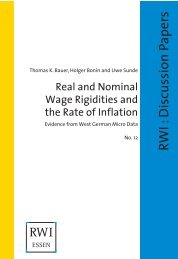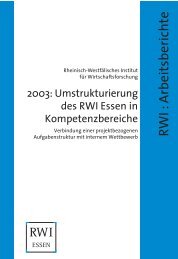Gender Segregation and Gender Wage Differences during the Early ...
Gender Segregation and Gender Wage Differences during the Early ...
Gender Segregation and Gender Wage Differences during the Early ...
You also want an ePaper? Increase the reach of your titles
YUMPU automatically turns print PDFs into web optimized ePapers that Google loves.
ning <strong>and</strong> Swaffield, 2008, Loprest, 1992, <strong>and</strong> Bertr<strong>and</strong>, Goldin, <strong>and</strong> Katz,<br />
2010). It, however, differs from results obtained by Kunze (2005) for <strong>the</strong><br />
German labour market. Based on a sample of workers who finished <strong>the</strong>ir<br />
apprenticeship between 1975 <strong>and</strong> 1990, she finds that <strong>the</strong> wage differential<br />
between male <strong>and</strong> female workers stays constant throughout <strong>the</strong> early career.<br />
These diverse results for Germany might be related to <strong>the</strong> different<br />
time periods <strong>and</strong> worker samples used for <strong>the</strong> analysis.<br />
Concerning gender segregation, Table A.7 suggests that <strong>the</strong> impact of<br />
<strong>the</strong> differential allocation to industries, occupations, establishments <strong>and</strong><br />
job-cells is particularly large at <strong>the</strong> beginning of <strong>the</strong> working career, but<br />
decreases as labour market experience elapses. For example, at <strong>the</strong> time<br />
of labour market entry, female workers employed in <strong>the</strong> same occupation<br />
as <strong>the</strong>ir male counterparts earn about 0.063 log points less. This withinoccupation<br />
gender wage differential gradually increases <strong>during</strong> <strong>the</strong> early<br />
labour market career <strong>and</strong> reaches 0.112 log points ten years after entry. A<br />
similar pattern emerges when <strong>the</strong> aspect of fur<strong>the</strong>r segregation into jobcells<br />
is taken into account. In particular, <strong>during</strong> <strong>the</strong> early career <strong>the</strong> wage<br />
differential within job-cells gradually increases from 0.028 log points to<br />
0.081 log points. This implies, as already mentioned above, that women’s<br />
concentration in lower-paying jobs almost entirely accounts for <strong>the</strong> lower<br />
entry wages received by female workers. The contribution of gender segregation<br />
gradually decreases with rising work experience, implying that, ten<br />
years after labour market entry, half of <strong>the</strong> gender wage differential remains<br />
unexplained.<br />
In order to examine why women’s wage disadvantages increase <strong>during</strong><br />
<strong>the</strong> early labour market career, I pool all individual-year observations <strong>and</strong><br />
estimate Equation (2) including different sets of explanatory variables. Estimation<br />
results without controlling for <strong>the</strong> different types of labour market<br />
segregation are displayed in Table A.8. The mean gender wage differential<br />
of 0.132 log points (cf. Table 5.5) slightly reduces to 0.128 log points<br />
when educational level <strong>and</strong> year of observation is controlled for. As already<br />
shown in <strong>the</strong> descriptive statistics, <strong>during</strong> <strong>the</strong> early labour market career<br />
women accumulate somewhat longer work experience than men. Therefore,<br />
augmenting <strong>the</strong> model with a quadratic term for months of actual fulltime<br />
experience <strong>and</strong> a dummy variable indicating nonemployment spells of at<br />
least six months raises <strong>the</strong> gender wage differential to 0.143 log points. The<br />
gender differences in young workers’ mobility patterns can only account for<br />
a wage differential of 0.002 log points. More precisely, <strong>the</strong> additional inclusion<br />
of dummy variables, which indicate whe<strong>the</strong>r an employer <strong>and</strong> occupa-<br />
16


